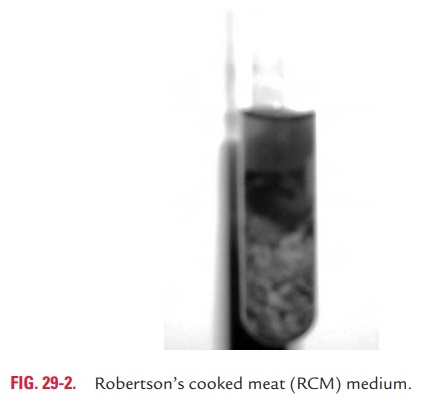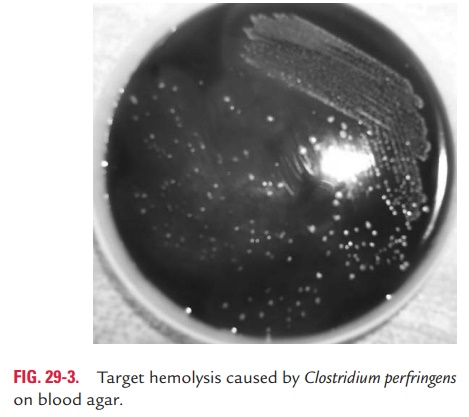Chapter: Microbiology and Immunology: Bacteriology: Clostridium
Clostridium perfringens: Properties of the Bacteria
Clostridium perfringens
C. perfringens is the most important Clostridium species causinggas gangrene, a severe life-threatening disease. The bacteria also cause necrotic enteritis and food poisoning.
Properties of the Bacteria
◗ Morphology
C. perfringens shows following morphological features:
· C. perfringens is a large, rectangular, Gram-positive bacillusmeasuring 4–6 m in length; it is a straight bacillus with parallel sides and round and truncated ends.
· The bacilli occur as single, in chains, or in bundles. The bacilli are capsulated.
· The bacilli are nonmotile, however, the bacteria multiply rapidly, giving a characteristic spreading colony appearance on the media, resembling the growth of motile clostridia.
· They possess central or subterminal spores. The spores, however, are rarely seen either in clinical specimens from lesions or in culture media.
◗ Culture
C. perfringens is an anaerobic but aerotolerant bacterium. The bac-teria can grow under microaerophilic conditions and do not die on exposure to air. They grow at a temperature range of 20–44°C (optimum temperature 37°C) and a pH range of 5.5–8.0.
1. Robertson’s cooked meat (RCM) broth: C. perfringensgrows rapidly in tissues and in culture media. In RCM medium, C. perfringens produces good growth. The meat is not digested but is turned pink. It produces an acidic reaction and a sour odor in the culture. Some strains of C. perfringens can grow optimally at 45°C with a generation time reduced to 10 minutes. This property is made use of in the isolation of C. perfringens in RCM medium (Fig. 29-2), when specimens are contaminated with other clostridial species. Inoculation of the specimens in RCM media followed by incubation at 45°C for 4–6 minutes and subsequently culturing on blood agar produces pure and predominant colonies of C. perfringens.

2. Blood agar: On blood agar containing human, sheep, orrabbit blood, C. perfringens on prolonged incubation produces dual zone of hemolysis (Fig. 29-3, Color Photo 27). This is due to a narrow zone of complete hemolysis by theta-toxin and a much wider zone of incomplete hemolysis by the alpha-toxin of the bacteria.

◗ Biochemical reactions
perfringens shows following reactions:
· C. perfringens is metabolically active. The bacteria fermentglucose, lactose, sucrose, and maltose with the production of acid and gas.
· They produce H2S and reduce nitrate to nitrite.
· They are MR positive, VP negative, and indole negative.
· They ferment lactose with the production of acid in litmus milk. The color of the medium changes from blue to red. Casein of the milk is coagulated by the production of acid and the coagulated milk is broken down by the production of large volume of gas. Due to the release of gas, the paraffin plug is pushed up with shreds of broken clot adhering to the sides of the glass tube. This reaction is known as stormyfermentation, characteristic ofC. perfringens.
◗ Other properties
Susceptibility to physical and chemical agents: C. perfringensspores are killed within 5 minutes by boiling, but spores of cer-tain strains (food poisoning strain of type A, certain strains of type C) are killed by boiling for a longer period of 1–3 hours. The spores are also killed by autoclaving at 121°C for 15 minutes. C. perfringens spores are resistant to commonly used antisepticsand disinfectants. The bacilli are sensitive to metronidazole and penicillins.
Typing: On the basis of four major toxins (alpha-, beta-,epsilon-, and iota-toxin) produced by C. perfringens, strains of C. perfringensare classified into five types (A, B, C, D, and E).Typing of strains is carried out by in vivo test in animals. This is carried out by neutralization of the toxins with specific antitox-ins via intravenous or percutaneous injections in mice.
Related Topics